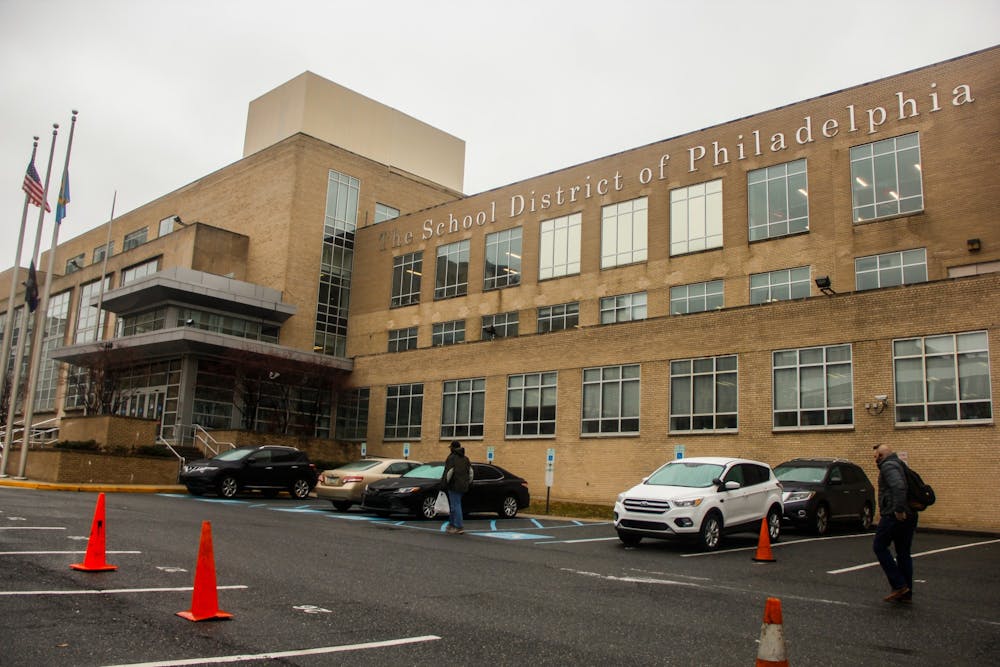
The School District of Philadelphia building on Jan. 26.
Credit: Gary LinThe term “school choice” is defined as “a program or policy in which students are given the choice to attend a school other than their district's public school.” Typically, this results in school districts broadening the types of schools they have, which manifests itself in an expansion of the types of schools available to most students, which often include magnet, charter, or private schools. While I would imagine this to be a fairly uncontroversial definition, Republicans and Democrats have remained divided on this issue for decades.
In light of increasing conversations surrounding parental involvement in education, school choice issues have grown in national prominence over the past election cycle. As a tutor with the West Philadelphia Tutoring Project, I’ve been able to get a glimpse into the lived experience of Philadelphia public school students. Combined with work on Board of Education races in my own city, it’s caused me to reflect on my own 13 years as a public school student. These realities, juxtaposed with that of many of my Penn peers who attended private schools, led me to an interesting question: Why should the quality of education your child receives be based on your income?
The School District of Philadelphia poses a unique example on the implementation of school choice policies. In a city with one of the largest school districts in the country, the Philadelphia Board of Education is appointed, rather than elected, creating accusations of little transparency. This poses accountability red flags, making it difficult for parents to express their concerns at the ballot box. The district also has seen increasing disparity in achievement among racial and socioeconomic groups, with only 32% of children in the third grade meeting the appropriate reading levels.
Philadelphia, unlike many other urban centers throughout the country, also has an expansive charter school system. In Philadelphia, charter schools receive district and state funding while also operating outside various city and state restrictions. A 2015 Stanford study which looked at urban charter schools found that, in Philadelphia, socioeconomically disadvantaged students at charter schools learned more than their comparable peers at district schools in the city. District reports have continued to show similar results, although not all charter schools participate in the studies.
We’ve seen similar results at the relatively new elementary charter schools in my home city of Stamford, Conn. Waterside School serves an almost entirely economically disadvantaged population and yet has significantly higher reading and math proficiencies than both city and state standards. The Stamford Charter School for Excellence, founded in 2015, has seen the same: With a population of 98% children of color, 98% of students met proficiency in math and 87% did so in reading, earning them a ranking among U.S. News & World Report Top Schools in Connecticut.
Critics of charter schools will often point to the “choice” oriented nature of these schools, arguing that because of their opt-in nature these schools don’t adequately represent the low-income populations of their cities. Similarly, they will often claim self-aggrandizing, wealthy boards of trustees advocate for overly innovative curricula. This rhetoric essentially says that financially disadvantaged parents don’t deserve, or have the capabilities, to make choices about which programs best suit their child’s needs in the same way wealthy parents who send their children to private schools do.
In cities with wealth-based achievement gaps like Philadelphia, where city-funded magnet schools often disproportionately serve wealthy students, this becomes even more problematic. These measurements don't even take into account the infrastructure conditions of these schools, many of which are deplorable. As someone who lived through my district’s mold crisis, and whose high school is being demolished, I was particularly saddened to see the conditions that many of the Philadelphia public schools were faced with during my time with the West Philadelphia Tutoring Project.
Penn’s failure to pay Payments in Lieu of Taxes and the University’s tax-exempt status continues to help perpetuate these problems. These issues are compounded by Penn’s more favorable admittance of wealthier students across the board. This holds true within the Philadelphia school district as well, often accepting significant numbers of students from magnet schools like Masterman and Central High schools. These schools have been criticized for their admissions processes, resulting in a process overhaul this year.
While the existence of charter schools doesn’t repair this problem, they can offer distinctive programs which make students more competitive in the college admissions process. One example is the incorporation of required professional experiences in schools like Philadelphia’s Mastery Charter, which requires an 18-week internship in 10th grade as well as other supplemental career readiness programs. As Penn students, we are all well aware of the invaluable difference these experiences can make in college admissions.
Charter schools may not be the perfect solution to fixing America’s education system, but they do provide a band-aid over a wound which can, if done correctly, marginally tip the scales of wealth inequality in education. The simple fact is that every parent deserves a say in their child’s education, no matter how much money they make. Before advocating against vaguely labeled “school choice” policies, be sure to consider the impacts that parental involvement can have on a child’s success.
LEXI BOCCUZZI is a College sophomore studying philosophy, politics, and economics from Stamford, Conn. Her email is abb628@sas.upenn.edu.
The Daily Pennsylvanian is an independent, student-run newspaper. Please consider making a donation to support the coverage that shapes the University. Your generosity ensures a future of strong journalism at Penn.
Donate






